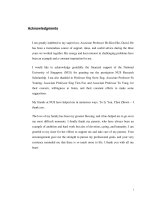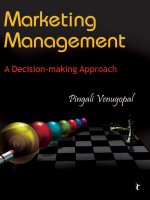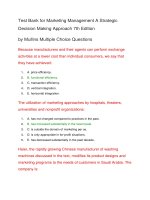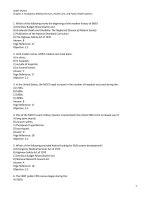Business statistics a decision making approach 6th edition ch18ppln
Bạn đang xem bản rút gọn của tài liệu. Xem và tải ngay bản đầy đủ của tài liệu tại đây (135.11 KB, 29 trang )
Business Statistics:
A Decision-Making Approach
6th Edition
Chapter 18
Introduction to Decision
Analysis
Business Statistics: A Decision-Making Approach, 6e © 2010 PrenticeHall, Inc.
Chap 18-1
Chapter Goals
After completing this chapter, you should be able
to:
Describe the decision environments of certainty and
uncertainty
Construct a payoff table and an opportunity-loss table
Define and apply the expected value criterion for decision
making
Compute the value of perfect information
Develop and use decision trees for decision making
Business Statistics: A Decision-Making Approach, 6e © 2010 PrenticeHall, Inc.
Chap 17-2
Decision Making Overview
Decision Making
Decision Environment
Decision Criteria
Certainty
Nonprobabilistic
Uncertainty
Probabilistic
Business Statistics: A Decision-Making Approach, 6e © 2010 PrenticeHall, Inc.
Chap 17-3
The Decision Environment
Decision Environment
Certainty
*
Certainty: The results of decision
alternatives are known
Example:
Must print 10,000 color brochures
Uncertainty
Offset press A: $2,000 fixed cost
+ $.24 per page
Offset press B: $3,000 fixed cost
+ $.12 per page
Business Statistics: A Decision-Making Approach, 6e © 2010 PrenticeHall, Inc.
Chap 17-4
The Decision Environment
(continue
d)
Uncertainty: The outcome that
will occur after a choice is
unknown
Decision Environment
Example:
Certainty
Uncertainty
*
You must decide to buy an item
now or wait. If you buy now the
price is $2,000. If you wait the
price may drop to $1,500 or rise
to $2,200. There also may be a
new model available later with
better features.
Business Statistics: A Decision-Making Approach, 6e © 2010 PrenticeHall, Inc.
Chap 17-5
Decision Criteria
Nonprobabilistic Decision Criteria:
Decision rules that can be
applied if the probabilities of
uncertain events are not known.
maximax criterion
maximin criterion
Decision Criteria
*
Nonprobabilistic
Probabilistic
minimax regret criterion
Business Statistics: A Decision-Making Approach, 6e © 2010 PrenticeHall, Inc.
Chap 17-6
Decision Criteria
(continue
d)
Probabilistic Decision Criteria:
Consider the probabilities of
uncertain events and select an
alternative to maximize the
expected payoff of minimize the
expected loss
Decision Criteria
Nonprobabilistic
*
Probabilistic
maximize expected value
minimize expected opportunity loss
Business Statistics: A Decision-Making Approach, 6e © 2010 PrenticeHall, Inc.
Chap 17-7
A Payoff Table
A payoff table shows alternatives,
states of nature, and payoffs
Investment
Choice
(Alternatives)
Profit in $1,000’s
(States of Nature)
Strong
Economy
Large factory
200
Average factory
90
Small
Business
Statistics:factory
A Decision-Making Approach, 6e ©40
2010 PrenticeHall, Inc.
Stable
Economy
Weak
Economy
50
120
30
-120
-30
20
Chap 17-8
Maximax Solution
The maximax criterion (an optimistic approach):
1. For each option, find the maximum payoff
Investment
Choice
(Alternatives)
Profit in $1,000’s
(States of Nature)
Strong
Economy
Stable
Economy
Large factory
200
50
Average factory
90
120
Business
A Decision-Making Approach,
6e © 2010 PrenticeSmallStatistics:
factory
40
30
Hall, Inc.
1.
Weak
Economy
-120
-30
20
Maximum
Profit
200
120
40
Chap 17-9
Maximax Solution
(continue
d)
The maximax criterion (an optimistic approach):
1. For each option, find the maximum payoff
2. Choose the option with the greatest maximum payoff
Investment
Choice
(Alternatives)
Profit in $1,000’s
(States of Nature)
Strong
Economy
Stable
Economy
Large factory
200
50
Average factory
90
120
Business
A Decision-Making Approach,
6e © 2010 PrenticeSmallStatistics:
factory
40
30
Hall, Inc.
Weak
Economy
-120
-30
20
1.
2.
Maximum
Profit
Greatest
maximum
is to
choose
Large
factory
200
120
40
Chap 17-10
Maximin Solution
The maximin criterion (a pessimistic approach):
1. For each option, find the minimum payoff
Investment
Choice
(Alternatives)
Profit in $1,000’s
(States of Nature)
Strong
Economy
Stable
Economy
Large factory
200
50
Average factory
90
120
Business
A Decision-Making Approach,
6e © 2010 PrenticeSmallStatistics:
factory
40
30
Hall, Inc.
1.
Weak
Economy
-120
-30
20
Minimum
Profit
-120
-30
20
Chap 17-11
Maximin Solution
(continue
d)
The maximin criterion (a pessimistic approach):
1. For each option, find the minimum payoff
2. Choose the option with the greatest minimum payoff
Investment
Choice
(Alternatives)
Profit in $1,000’s
(States of Nature)
Strong
Economy
Stable
Economy
Large factory
200
50
Average factory
90
120
Business
A Decision-Making Approach,
6e © 2010 PrenticeSmallStatistics:
factory
40
30
Hall, Inc.
1.
Weak
Economy
-120
-30
20
Minimum
Profit
-120
-30
20
2.
Greatest
minimum
is to
choose
Small
factory
Chap 17-12
Opportunity Loss
Opportunity loss is the difference between an actual
payoff for a decision and the optimal payoff for that state
of nature
Investment
Choice
(Alternatives)
Large factory
Average factory
Small factory
Payoff
Table
Profit in $1,000’s
(States of Nature)
Strong
Economy
Stable
Economy
Weak
Economy
200
90
40
50
120
30
-120
-30
20
The choice “Average factory” has payoff 90 for “Strong Economy”. Given
“Strong Economy”, the choice of “Large factory” would have given a
payoff of 200, or 110 higher. Opportunity loss = 110 for this cell.
Business Statistics: A Decision-Making Approach, 6e © 2010 PrenticeHall, Inc.
Chap 17-13
Opportunity Loss
Investment
Choice
(Alternatives)
Large factory
Average factory
Small factory
Profit in $1,000’s
(States of Nature)
Strong
Economy
Stable
Economy
200
90
40
50
120
30
Investment
Choice
(Alternatives)
Large factory
Business Statistics: A Decision-Making Approach,
6e © 2010
PrenticeAverage
factory
Hall, Inc.
Small factory
(continue
d)
Payoff
Table
Weak
Economy
Opportunity
-120
Loss Table
-30
20
Opportunity Loss in $1,000’s
(States of Nature)
Strong
Economy
Stable
Economy
0
110
160
70
0
90
Weak
Economy
140
50
Chap 17-14
0
Minimax Regret Solution
The minimax regret criterion:
1. For each alternative, find the maximum opportunity
loss (or “regret”)
Opportunity Loss Table
Investment
Choice
(Alternatives)
Opportunity Loss in $1,000’s
(States of Nature)
Strong
Economy
Stable
Economy
Large factory
0
70
Average factory
110
0
Business Statistics: A Decision-Making Approach, 6e © 2010 PrenticeHall,
Inc.
Small
factory
160
90
Weak
Economy
140
50
0
1.
Maximum
Op. Loss
140
110
160
Chap 17-15
Minimax Regret Solution
(continue
d)
The minimax regret criterion:
1. For each alternative, find the maximum opportunity
loss (or “regret”)
2. Choose the option with the smallest maximum loss
Opportunity Loss Table
Investment
Choice
(Alternatives)
Opportunity Loss in $1,000’s
(States of Nature)
Strong
Economy
Stable
Economy
Large factory
0
70
Average factory
110
0
Business Statistics: A Decision-Making Approach, 6e © 2010 PrenticeHall,
Inc.
Small
factory
160
90
Weak
Economy
140
50
0
1.
2.
Maximum
Op. Loss
Smallest
maximum
loss is to
choose
Average
factory
140
110
160
Chap 17-16
Expected Value Solution
The expected value is the weighted average
payoff, given specified probabilities for each state
of nature
Profit in $1,000’s
(States of Nature)
Investment
Choice
(Alternatives)
Large factory
Average factory
Small factory
Strong
Economy
(.3)
Stable
Economy
(.5)
Weak
Economy
(.2)
200
90
40
50
120
30
-120
-30
20
Business Statistics: A Decision-Making Approach, 6e © 2010 PrenticeHall, Inc.
Suppose these
probabilities
have been
assessed for
these states of
nature
Chap 17-17
Expected Value Solution
(continue
d)
Profit in $1,000’s
(States of Nature)
Investment
Choice
(Alternatives)
Large factory
Average factory
Small factory
Strong
Economy
(.3)
200
90
40
Stable
Economy
(.5)
50
120
30
Weak
Economy
(.2)
-120
-30
20
Expected
Values
61
81
31
Maximize
expected
value by
choosing
Average
factory
Example: EV (Average factory) = 90(.3) + 120(.5) + (-30)(.2)
= 81
Business Statistics: A Decision-Making Approach, 6e © 2010 PrenticeHall, Inc.
Chap 17-18
Expected Opportunity Loss
Solution
Opportunity Loss Table
Opportunity Loss in $1,000’s
(States of Nature)
Investment
Choice
(Alternatives)
Large factory
Average factory
Small factory
Strong
Economy
(.3)
Stable
Economy
(.5)
Weak
Economy
(.2)
0
110
160
70
0
90
140
50
0
Expected
Op. Loss
(EOL)
63
43
93
Minimize
expected
op. loss by
choosing
Average
factory
Example: EOL (Large factory) = 0(.3) + 70(.5) + (140)(.2)
= 63
Business Statistics: A Decision-Making Approach, 6e © 2010 PrenticeHall, Inc.
Chap 17-19
Cost of Uncertainty
Cost of Uncertainty (also called Expected Value
of Perfect Information, or EVPI)
Cost of Uncertainty
= Expected Value Under Certainty (EVUC)
– Expected Value without information (EV)
so:
EVPI = EVUC – EV
Business Statistics: A Decision-Making Approach, 6e © 2010 PrenticeHall, Inc.
Chap 17-20
Expected Value Under
Certainty
Expected
Value Under
Certainty
(EVUC):
EVUC =
expected
value of the
best decision,
given perfect
information
Profit in $1,000’s
(States of Nature)
Investment
Choice
(Alternatives)
Large factory
Average factory
Small factory
Strong
Economy
(.3)
Stable
Economy
(.5)
Weak
Economy
(.2)
200
90
40
50
120
30
-120
-30
20
200
120
20
Example: Best decision
given “Strong Economy” is
“Large factory”
Business Statistics: A Decision-Making Approach, 6e © 2010 PrenticeHall, Inc.
Chap 17-21
Expected Value Under
Certainty
(continue
Profit in $1,000’sd)
(States of Nature)
Investment
Choice
(Alternatives)
Now weight
these outcomes
with their
probabilities to
find EVUC:
Large factory
Average factory
Small factory
Strong
Economy
(.3)
Stable
Economy
(.5)
Weak
Economy
(.2)
200
90
40
50
120
30
-120
-30
20
200
120
20
EVUC = 200(.3)+120(.5)+20(.2)
= 124
Business Statistics: A Decision-Making Approach, 6e © 2010 PrenticeHall, Inc.
Chap 17-22
Cost of Uncertainty Solution
Cost of Uncertainty (EVPI)
= Expected Value Under Certainty (EVUC)
– Expected Value without information (EV)
Recall:
EVUC = 124
EV is maximized by choosing “Average factory”,
where EV = 81
so:
EVPI = EVUC – EV
= 124 – 81
= 43
Business Statistics: A Decision-Making Approach, 6e © 2010 PrenticeHall, Inc.
Chap 17-23
Decision Tree Analysis
A Decision tree shows a decision problem,
beginning with the initial decision and ending
will all possible outcomes and payoffs.
Use a square to denote decision nodes
Use a circle to denote uncertain events
Business Statistics: A Decision-Making Approach, 6e © 2010 PrenticeHall, Inc.
Chap 17-24
Sample Decision Tree
Strong Economy
Large factory
Stable Economy
Weak Economy
Strong Economy
Average factory
Stable Economy
Weak Economy
Strong Economy
Small factory
Stable Economy
Weak Economy
Business Statistics: A Decision-Making Approach, 6e © 2010 PrenticeHall, Inc.
Chap 17-25









